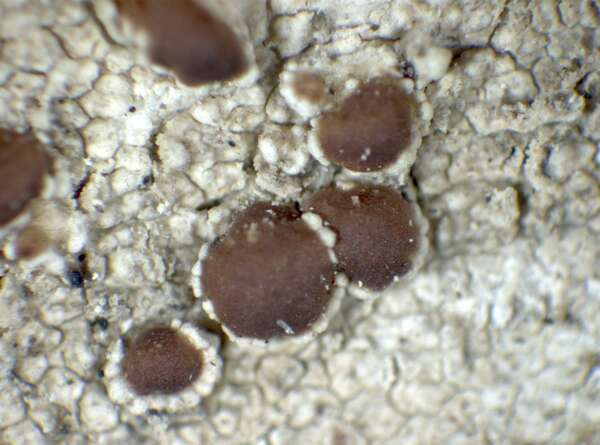Lecanora insignis Degel.
Ark. Bot. 30A, 3: 53, 1942.
Synonyms:
Distribution:
Description: Thallus crustose, episubstratic, mostly continuous, smooth to slightly verrucose, white to pale grey. Apothecia lecanorine, round to irregular in outline, 0.6-0.8 mm across, adnate to sessile and constricted at base, with a brown to reddish brown, flat to convex disc, and an irregular, discontinuous thalline margin which is often reduced to a few, distant, whitish granules. Thalline exciple pulicaris-type, with very large crystals of calcium oxalate (up to 100 μm) soluble in N; epithecium yellow-brown, with large crystals, chlarotera-type, P+ orange-red; hymenium colourless, 60-90 µm high; paraphyses weakly branched and anastomosing, 2-3 µm thick, slightly thickened at apex; hypothecium colourless, 20-40 µm high. Asci 8-spored, clavate, very thin-walled, with a K/I+ blue, tall tholus penetrated by a faintly amyloid apical cushion, the wall K/I-, surrounded by a blue outer layer, Lecanora-type. Ascospores 1-celled, hyaline, broadly ellipsoid, (12-)14-20 x (6-)8-12(-15) µm, the wall 1-1.2(-1.5) µm thick. Photobiont chlorococcoid. Spot tests: thallus K+ yellow, C-, KC-, P+ orange-yellow; apothecial disc and margin P+ orange-red. Chemistry: thallus with atranorin(major) and roccellic acid; apothecia with pannarin.Note: a rare species of the L. subfusca-group, peculiar in having large, thick-walled ascospores; apparently restricted to the bark of coniferous trees in humid montane forests; never reported from Italy but known from the Alps, and to be looked for there.
Growth form: Crustose
Substrata: bark
Photobiont: green algae other than Trentepohlia
Reproductive strategy: mainly sexual

Predictive model
Growth form: Crustose
Substrata: bark
Photobiont: green algae other than Trentepohlia
Reproductive strategy: mainly sexual

Predictive model
 Index Fungorum
Index Fungorum
 GBIF
GBIF



